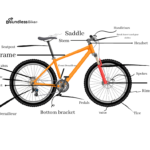It is important to know that it takes a lot of work to lose weight. There are many diet plans, workout regimes and other activities that you can do. However, the most effective way is by burning calories.
Riding a bike is one of the best ways to burn calories and lose weight. It is a great exercise for your heart and lungs, and is also a good way to relieve stress and anxiety. The good thing about cycling is that it can be done at any age and in any location. It doesn’t need much space or time either.

The number of calories you can burns varies depending on your current body weight, height, maximum heart rate, resting metabolic rate (RMR), activity levels, training age/history, etc. This article will give you some insight on how much cycling to burn 2000 calories.
How much cycling to burn 2000 calories?
The average person that weighs 70kg (154 pounds) and cycles at a moderate pace of 12-13.9 mph, can expect to burn 2000 calories in 3 hours 24 minutes. In other words, you will need to ride about 40 miles to burn 2000 calories.
To help you figure out how many calories you burn, use the following equation:
Calories burned per minute = (METs x 3.5 x your body weight in kilograms) / 200
One MET is approximately 3.5 milliliters of oxygen consumed per kilogram (kg) of body weight per minute.
The MET value for cycling at 12-13.9 mph with moderate effort is 8. Check MET values for different types of bicycling here .
(If you don’t know what are METs, check out here or here.)
After knowing the number of calories burned per minute, you can calculate the time needed to burn your desired calories. The formula to use is:
Time needed (minutes) = 2000/calories burned per minute
For example, if you weigh 90kg (198 pounds) and you ride a bike at 10-11.9 mph, which have a MET value of 6.8 then your calorie burn per minute is 6.8 x 3.5 x 90 /200 = 10.71 calories burned per minute. Time needed to burn 2000 calories = 2000/10.71= 187 minutes = 3 hours 6 minutes.
Calories burned based on your weight and the speed you ride
These estimates are based on your weight and the speed you ride.
| Weight | Speed | Time to burn 2000cal | How far to burn 2000cal |
| 55kg | 13mph/21kph | 4 hours 32 minutes | 58.9 miles |
| 55kg | 15mph/24kph | 3 hours 38 minutes | 54.45 miles |
| 55kg | 18mph/29kph | 3 hours | 54 miles |
| 75kg | 13mph/21kph | 3 hours 20 minutes | 43.29 miles |
| 75kg | 15mph/24kph | 2 hours 40 minutes | 40.05 miles |
| 75kg | 18mph/29kph | 2 hours 13 minutes | 39.96 miles |
| 90kg | 13mph/21kph | 2 hours 46 minutes | 35.88 miles |
| 90kg | 15mph/24kph | 2 hours 13 minutes | 33.3 miles |
| 90kg | 18mph/29kph | 1 hours 51 minutes | 33.3 miles |
As you can see from the table above, a person weighing 90kg will need less time to burn 2000 calories than a 55kg person, going at18 mph. In doing the same task for the same amount of time, people who are heavier expend more energy than lighter people.
Calories burned by various types of cycling
Cycling 14-15.9 mph, racing or leisure, fast, vigorous effort (with MET value of 10) – It takes about 2 hours 23 minutes to burn 2000 calories.
Cycling 16-19 mph, racing/not drafting or > 19 mph drafting, very fast, racing general (with MET value of 12) – It takes about 1 hours 58 minutes to burn 2000 calories.
Cycling > 20 mph, racing, not drafting (with MET value of 15.8) – It takes about 1 hours 30 minutes to burn 2000 calories.
Mountain bike or BMX (with MET value of 8.5) – It takes about 2 hours 48 minutes to burn 2000 calories.
Unicycling (with MET value of 5) – It takes about 4 hours 45 minutes to burn 2000 calories.
(These calculations are based on a person weighing 80 kg, or 176 pounds.)
FAQs
How To Accurate Receive Calories Burnt Per Hour
The easy way to accurately calculate your calories burnt per hour is by using a heart rate monitor.
A heart rate monitor is a device that measures the heart rate of the person wearing it. It can be used to measure one’s physical condition, as well as to provide feedback on how well an individual is recovering from exercise.
There are two types of heart rate monitors – chest-straps and fitness watches. Chest-straps are more accurate than fitness watches, but they also require more work to wear and take off since they have to be strapped around the chest. Fitness watches are easier to wear and take off, but they’re less accurate than chest-straps.
How do cyclists lose weight?
Some tips for cyclists to lose weight: Ride often, ride to work, more sleep, eat little and often (5-6 small meals), avoid sugar and processed food.
Does cycling reduce weight?
Cycling is one of the best ways to lose weight. It helps to burn calories and improve your overall health, which will help you in your goal of losing weight.. However, it is important to ensure that you are eating the right foods in order to maintain your energy levels and prevent muscle fatigue.
What to eat during cycling?
A cyclist needs to eat both carbohydrates and protein in order to fuel their muscles. Some foods are high in both, while others are high in one but not the other.
Carbohydrates provide the energy that you need during your ride. The type of carbohydrate you eat will depend on how long you’re cycling for and what kind of activity you’re doing. Low-intensity cycling or a short ride is best fuelled with a bottle of water or electrolyte drink, while longer rides require something starchy like sweet potato, rice or porridge. You can also get carbs from wholemeal pasta or bread if you’re going for a low-carb diet.
Protein is important for muscle repair and growth after exercise, so it’s important to eat some protein as well as carbohydrates when exercising intensely.
Hope this article answered your question! Happy cycling!






